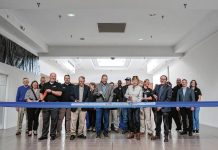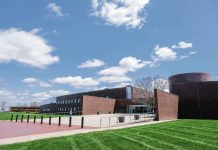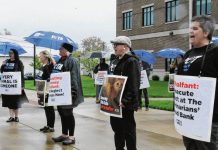A new way of estimating the economic impact of sports tourism programs in small American cities shows a sizable benefit to Columbus.
Sports tourism programs in the city had an economic impact of about $9.2 million in 2012, $9.8 million in 2013 and $10.9 million in fiscal year 2014, according to the method created by Ryan Brewer, assistant professor of finance at IUPUC, and Kayla Freeman, a doctoral student in finance in Indiana University’s Kelley School of Business.
The study came out of a request by the Columbus Area Visitors Center to know if it was getting a meaningful return on its investment in sports tourism, Brewer said. The findings were published in the Indiana Business Review.
“They’re getting a fantastic return,” Brewer said, noting that the city utilizes facilities originally built for use by residents.
[sc:text-divider text-divider-title=”Story continues below gallery” ]
“That’s the beauty of sports tourism in a community like ours — utilizing public and municipal facilities to bring outside dollars into the community that participants can use and enjoy. That’s really the benefit of the community hosting events,” said Karen Niverson, executive director of the Columbus Area Visitors Center.
Developing measurements
When he arrived at IUPUC in 2009, Brewer said, he was introduced to Lynn Lucas, who was then executive director of the Columbus Area Visitors Center. He also got to know Jim Dietz, then the center’s director of sports tourism, and Jim Henderson, head of the Columbus Sports Advisory Council. They learned of Brewer’s work in sports finance, such as assessing the value of college football programs.The city hosts a variety of tournaments in sports such as soccer, golf, softball and baseball. Some years, Columbus has hosted 80 or more tournaments, according to Visitors Center data.Traditional studies are labor intensive and involve event-specific surveying, which can be time consuming and expensive, particularly for a small community, Brewer said. Such a cost could make surveys financially unfeasible, he and Freeman wrote in their published study.
Brewer said that when he performs valuations of businesses, he tries to use relevant free economic data as much as possible. His thought was to do something similar for the economic impact of sports tourism.
“Why not make a recipe?” Brewer said.
One of the keys in the method used by Brewer and Freeman is using prior surveys of comparable-size cities with similar sporting events that have outlined expenditures by type. That helps determine average spending per visitor.
Freeman, a Westport native, did a lot of research to find comparable studies, Brewer said. He said he asked Freeman, upon a recommendation, to be part of the project because of her achievement as a student at IUPUC (4.0 GPA and valedictorian) and in the classes he taught.
Another key part of their method includes the estimated number of tourists, particularly the percentage of nonlocal tourists, because local spending cannot be considered new spending in the community, Brewer and Freeman wrote.
Adjustments for cost-of- living differences between communities also is factored into the nine-step process.
What results is the economic cash flow — an estimation of the net infusion of money into a local economy as a result of the initial direct spending of tourists over a specified time period.
Brewer said he was skeptical about what the results would yield.
“I certainly wasn’t sold that it was a good idea to do sports tourism,” he said.
The results, however, showed a significant return on investment.
Most importantly, traditional surveying of a half-dozen sports tourism events in Columbus — three this year and three last year — have shown the new estimating method to be accurate, he said. The results of the economic impact of sports tourism in Columbus, using the estimation model, are within 10 to 15 percentage points of traditional surveys, Brewer said.
“This helps us determine what events we want to go after,” Niverson said. “This gives us actual figures happening in Columbus rather than numbers on the state level.”
The Visitors Center works closely with the Columbus Parks and Recreation Department, the county parks department, Ceraland and Otter Creek on its sports tourism program, Niverson said.
Brewer and Freeman have been surveying a cross-section of events — golf, baseball, swimming, soccer and softball — to get a good picture of the impact, Niverson added.
She said the results are being analyzed and will be presented today to the Visitors Center Board.
Brewer said the results validated previous work by the Visitors Center to determine the economic impact of sports tourism, which showed a similar economic impact.
“We have seen that these numbers are close, and that makes us feel good,” Niverson said.
An estimation and survey of the economic impact of the Marquette University men’s basketball team showed even closer results between the two methods, Brewer said.
What’s at stake
Freeman said the method she and Brewer created provides an alternative way to get results quickly and inexpensively.Niverson said she’s pleased by the work of Brewer and Freeman and anticipates the Visitors Center will continue to use the model.Besides the cost savings the estimation method provides to a community, Brewer said it also can be used as a tool in capital investment decisions, such as whether a community should build a facility to attract more tournaments and teams to enhance its sports tourism industry.
For example, Boston turned down an opportunity to host the 2024 Olympic Summer Games because it deemed that the cost to build necessary infrastructure would outweigh the return on investment, Brewer said.
“It’s tough to make good decisions without a road map, so now they have a road map,” Brewer said.
Brewer said he has been contacted by some local arts groups, such as the Columbus Area Arts Council, to see if the estimation methods could be applied to its events.
[sc:pullout-title pullout-title=”9-step method for estimating economic impact” ][sc:pullout-text-begin]
Nine-step method for estimating economic impact, by Ryan Brewer and Kayla Freeman
1. Gather primary data
2. Identify key secondary study
3. Segment events
4. Calculate travel-party days
5. Estimate total nonlocal parties
6. Apply cost-of-living adjustment
7. Estimate total direct spending
8. Estimate total spending multiplier
9. Calculate estimated range of final demand economic impact
[sc:pullout-text-end]




